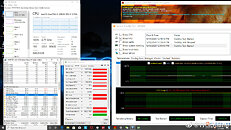Monday, May 11th 2020

Intel Core i9-10900K Stressed, Package Power Reads 235W, Temperatures 93°C
A stock Intel Core i9-10900K 10-core processor was subjected to FPU stress by Chinese PC enthusiast @WolStame. The power and temperature values of the processor are inside HEDT territory. With a Furmark GPU stress running on the side, under AIDA64 FPU stress, the i9-10900K measured a package power draw of up to 235.17 W, as measured using HWInfo64. The CPU package temperature shot up to 93 °C. A 240 mm AIO liquid CPU cooling solution was used in the feat. Interestingly, the processor is able to sustain clock speeds of 4.77 GHz, which is close to the advertised 4.80 GHz all-core turbo boost frequency, called for by the multi-core FPU stress.
To show that the values weren't obtained in a few seconds of test, the AIDA64 Stability Test window keeps a timestamp log and displays time elapsed into the stress. In this particular case, the all-core stress has been running for close to 48 minutes; and yet the processor is keeping up with its advertised all-core boost speed, making this an impressive feat.
Sources:
@WolStame (Weibo), @9550pro (Twitter)
To show that the values weren't obtained in a few seconds of test, the AIDA64 Stability Test window keeps a timestamp log and displays time elapsed into the stress. In this particular case, the all-core stress has been running for close to 48 minutes; and yet the processor is keeping up with its advertised all-core boost speed, making this an impressive feat.

110 Comments on Intel Core i9-10900K Stressed, Package Power Reads 235W, Temperatures 93°C
What motherboard is this with power limits all disabled?
4,9 GHZ allcore would be Thermal Velocity Boost, and you obviously won't reach this one with a cooling solution that does not fit this CPU.
A stressed 10 core running at 4800 in the same case as a maxed out 2080 is pretty decent if you ask me, which you haven’t. If you can’t get that air from the 2080 out, it’s gonna be warm in there no matter how you slice it.
Pros:
Very refined die process allows for high core clock even on cpu with a decent amount of cores.
Cons:
While it is refined, it is still 14nm and pushing high core clock out of a old uneficient process while slamming 2 ekstra cores in as well has a down side to it. High wattage use and that gives a hot running cpu as a side effect of high wattage use and clearly shows why it is about time intel moves to 10 or 7 nm now. 14nm is just to old now and way to uneficient.
And it's a goddamn 240mm AIO; it's not going to perform worse "than a lot of air coolers". 93C degrees is not even close to attaining the 70C requirement for TVB to kick in for that max rated 4.9 boost.
There's no wiggle room left on this process, period. All you can hope for is rolling the dice on a good 10-core bin that can shave off a few millivolts at the top end and stay stable.